Biology - Meiosis POGIL
1/72
Name | Mastery | Learn | Test | Matching | Spaced |
|---|
No study sessions yet.
73 Terms
According in Model 1, in what type of organs are the cells that enter meiosis I found?
The sex cells: ovaries/testes
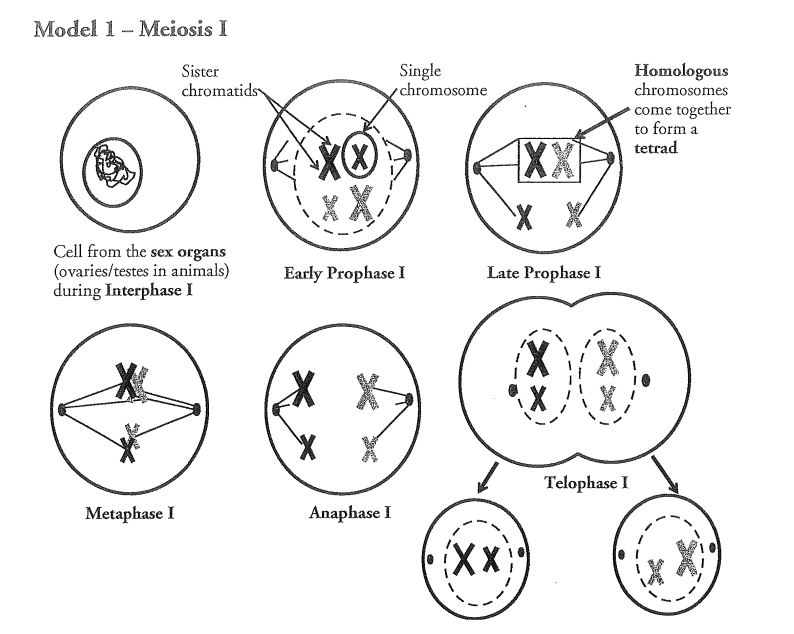
Considering what you already know about mitosis in cells, what event must take place during interphase before a cell proceeds to division?
DNA replication
What two structures make up a single replicated chromosome?
Sister chromatids
In Model 1, how many replicated chromosomes does the cell contain during prophase?
Four
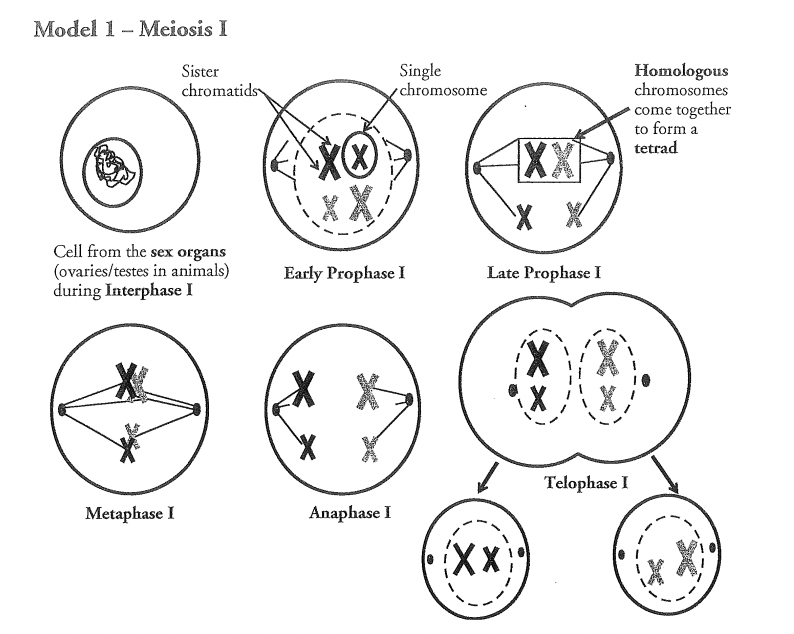
At which stage in meiosis I do the pairs of homologous chromosomes come together?
Late prophase I
Once the chromosomes have formed a pair, what are they called?
Tetrads
At the end of meiosis I, two cells have been produced. How many replicated chromosomes are in each of these cells?
Two
Cells with a full set of chromosomes are referred to as diploid o 2n, whereas cells with half the chromosomes are haploid or n. At which stage(s) of meiosis I are the cells diploid and at which stages are they haploid?
Diploid = Prophase, metaphase, and anaphase
Haploid = Telophase
Which of the statements below correctly describes the relationship between the cells at the end of telophase I and the original cell?
The new cells have two copies of half the genetic information in the original cell
(sister chromatids)
Considering the genetic makeup of the homologous pairs, will the cells at the end of telophase I be genetically identical to each other?
No, they will have one set of the same genes but may have different alleles.
According to Model 2, where did each of the cells come from that started meiosis II?
Meiosis I
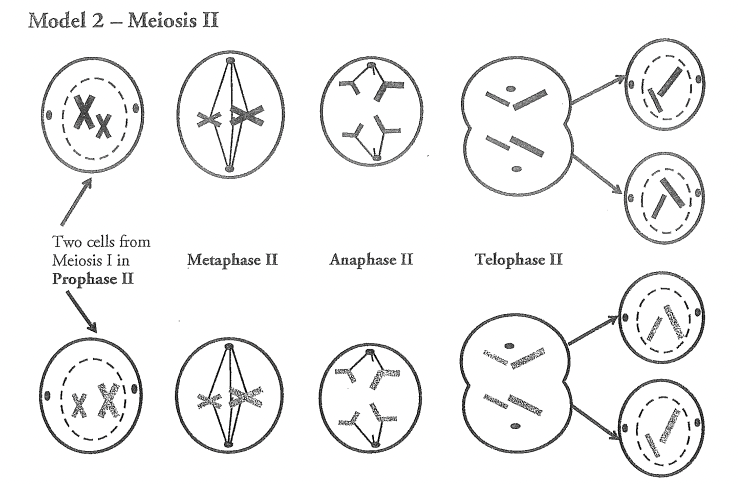
In meiosis I, during anaphase I, which structures separated - homologous chromosomes or sister chromatids?
Homologous chromosomes
In meiosis II, during anaphase II< which structures separated - homologous chromosomes or sister chromatids?
Sister chomatids
At the end of meiosis II are four daughter cells. Are they haploid or diploid?
The cells are haploid because they only have one set of the homologous pairs of chromosomes
Which of the statements below correctly describes the relationship between the cells at the end of meiosis II and the original cell?
The new cells have one copy of half of the genetic information in the original cell
According to Model 3, what is the name given to the cells produced at the end of meiosis I in males?
Secondary Spermocyte
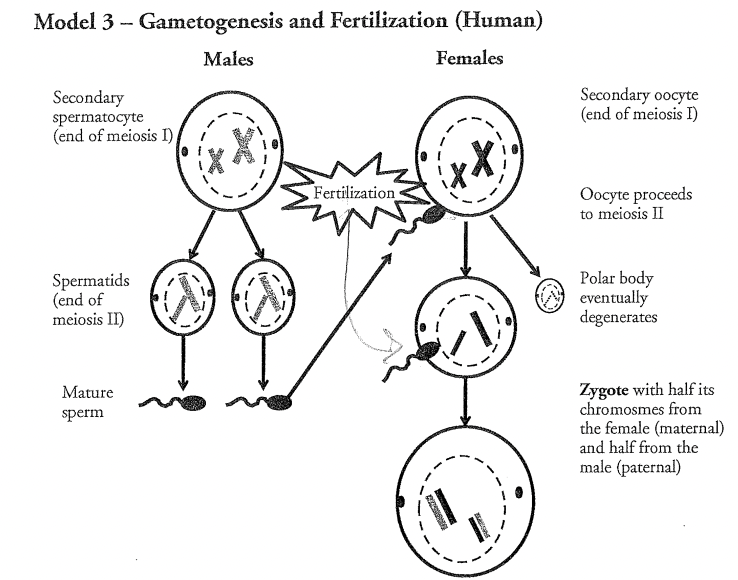
What is the name given to the cells produced at the end of meiosis I in females?
Secondary oocyte
Refer to Model 3; At the end of meiosis II in males, what cells are produced?
Spermatids
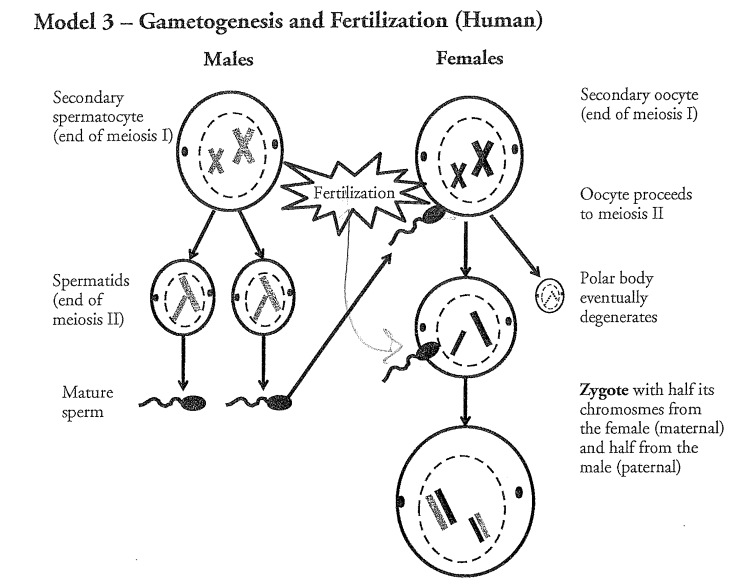
Refer to Model 3; What do these cells (from the previous question) eventually become?
Mature sperm
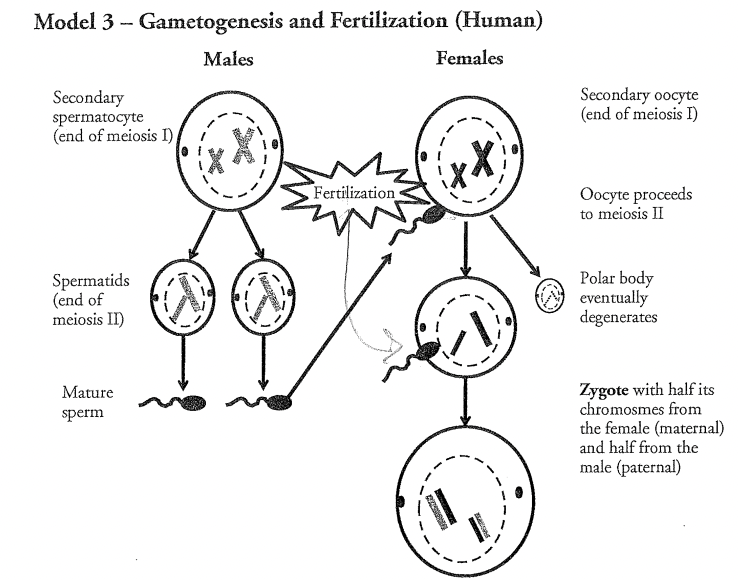
Before fertilization, what happens to the secondary oocyte?
Proceeds to meiosis II
(after sperm binds, but before it ends)
During fertilization which two cells come together? Be specific in your answer.
Mature sperm and secondary oocyte
During meiosis II, the secondary oocyte divides unevenly, with one cell (the ovum) receiving half of the chromosomes and nearly all the cytoplasm and organelles, while the other cell, the polar body, is much smaller and eventually degenerates. Propose an explanation to explain why the secondary oocyte divides in this way.
The ovum will need to divide many times and very quickly upon fertilization, so it must start large with all the organelles/cytoplasm it would need for the divisions.
What is the ploidy of the zygote produced by fertilization - haploid or diploid?
Diploid
What would the ploidy of the zygote be if egg and sperm were produced by mitosis rather than meiosis? How would this affect the ploidy of each successive generation?
4-ploid (quadraploid)
each successive generation would have twice the # chromosomes as the last
Write a statement to explain the origin of the chromosomes found in the zygote. Include the term homologous pair.
Half of the homologous pairs come from one parent and the other pair comes from another parent.
At which stage of meiosis are the chromosomes in Model 4?
Prophase I
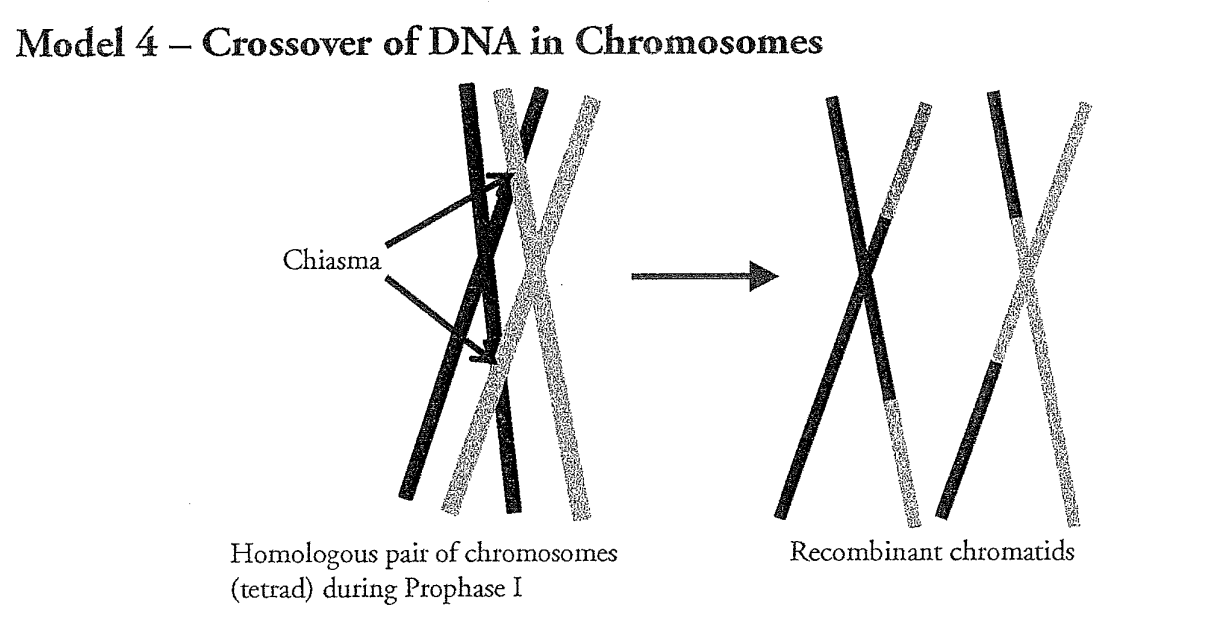
When the chromosomes come together as homologous pairs, the arms of the sister chromatids may cross over. What are these crossover points called?
Chiasma
Describe what happens to the chromatids during crossover.
They exchange pieces of chromosome (DNA)
What phrase is used to describe the chromatids after crossing over takes place and the homologous chromosomes separate?
Recombinant chromatids
Compare the recombinant chromatids with the original pair; Are the genes on a recombinant chromatid the same as the original chromatid?
Yes, because each chromosome in the homologous pair has the same genes in the same place.
Are the alleles on a recombinant chromatid the same as the original chromatid?
No, because the chromosomes in the homologous pair can have different alleles for each gene.
Model 5 is a condensed version of meiosis I. Notice the two possible arrangements of chromosomes in late prophase I. Considering what you know about DNA replication and meiosis, is either arrangement equally likely during the formation of tetrads in late prophase I? Explain.
Yes - it is random which chromosome of each pair goes into which cell.
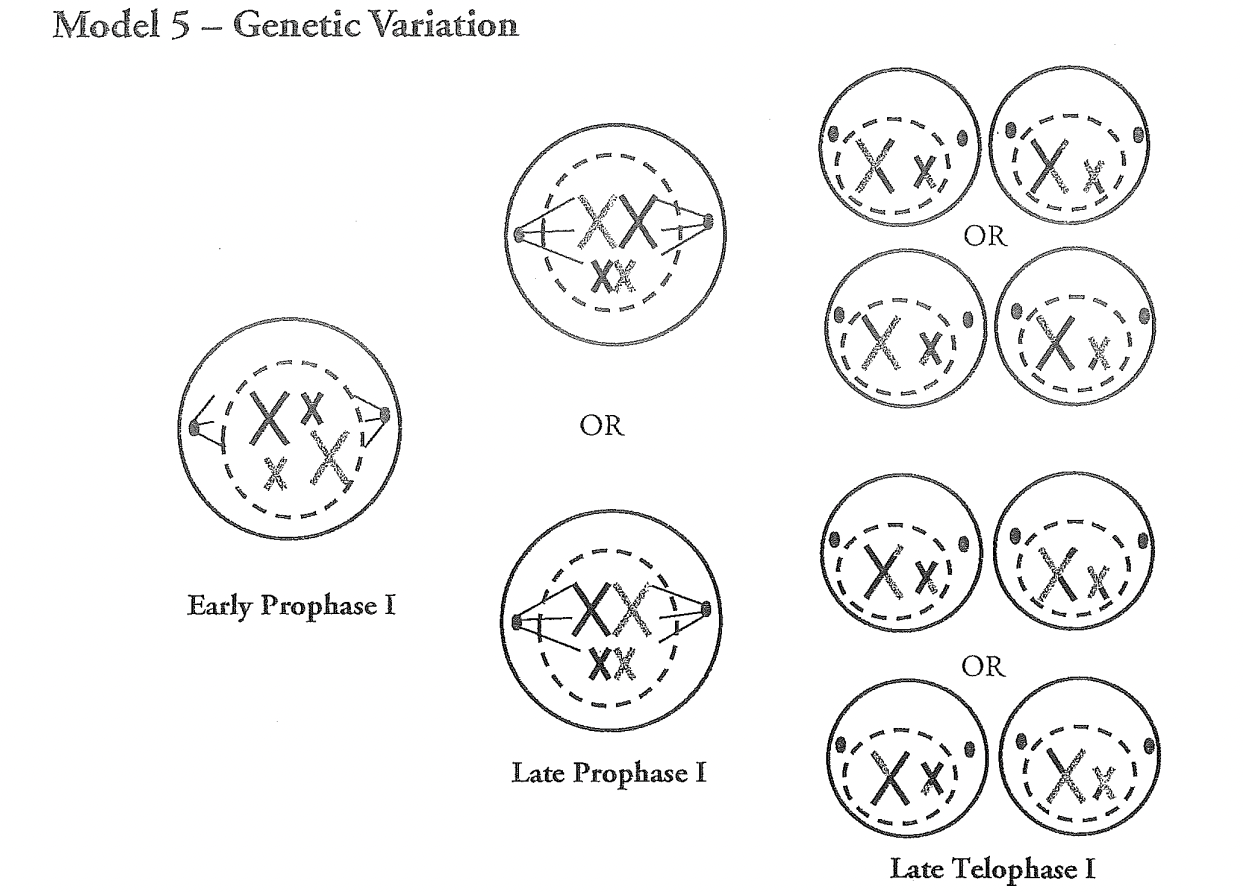
If there were three sets of homologous chromosomes in the cell in Model 5, how many possible arrangements would there be for the tetrads in late prophase I?
2x2x2 = 8 possible arrangements.
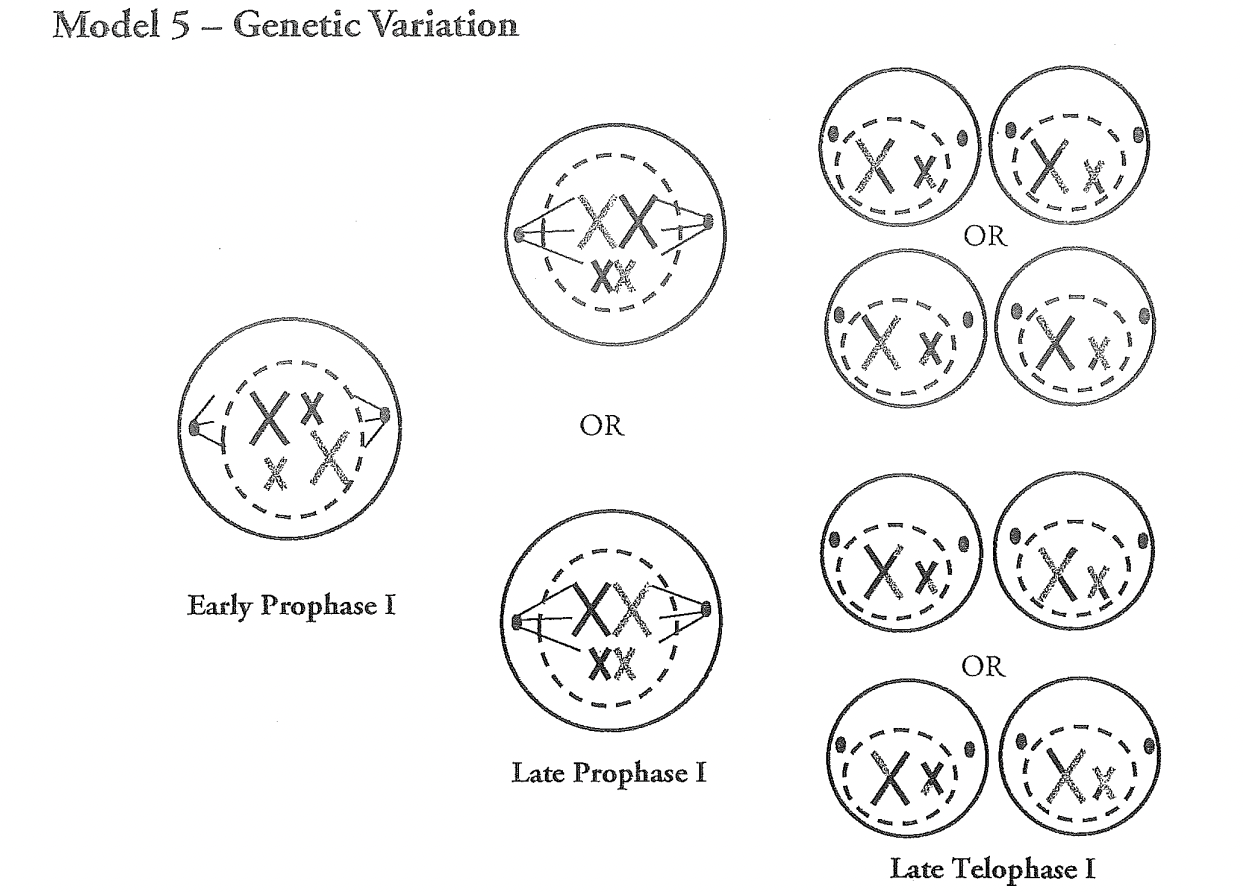
When homologous chromosome pairs align on the spindle during metaphase I the orientation of one pair is independent of the orientation of any other pair. This is known as independent assortment. Humans have 46 chromosomes, arranged as 23 pairs. During metaphase I each pair lines up independently, which results in 2 (23) possible combinations. Calculate the number of possible genetic combinations due to independent assortment.
2²³ = 8,388,608
Meiosis and sexual reproduction each lead to variation in the genetic make-up of every person. Explain how meiotic events, as well as the random fertilization of eggs and sperm, together lead to this genetic variation.
1) Independent assortment causes a mixing/scrambling of the homologous pairs
2) Crossing over causes exchanges of alleles on the homologous pairs
3) Random fertilization unites different combinations of maternal and paternal chromosomes
As a group, choose one set of daughter cells in late telophase I from Model 5. Imagine that those cells now undergo meiosis II. Draw at least four resulting haploid cells that could result.
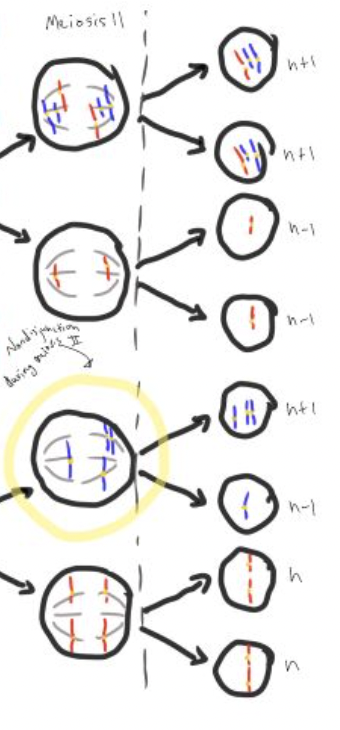
Prokaryote
Meiosis
Cell division that produces haploid (n ) cells (gametes )
Meiosis i
separation of homologous chromosomes. P1, M1, A`1, T1
Meiosis ii
separation of sister chromatids. P2, M2, A2, T2
Prokaryote
is a type of cellular organism that lacks a distinct nucleus and membrane-bound organelles in its cells.
Eukaryote
is an organism whose cells contain a true nucleus and membrane-bound organelles.
Interphase
is the longest phase of the cell cycle in which a cell spends the majority of its life cycle. It is the period between cell divisions, encompassing the time when a cell is actively carrying out its metabolic and cellular functions, preparing for cell division, and replicating its DNA. Interphase is divided into three subphases: G1 (Gap 1), S (Synthesis), and G2 (Gap 2).
Prophase
the initial stage of mitosis, which is a part of the cell cycle responsible for the division of a eukaryotic cell's nucleus into two daughter nuclei.
Metaphase
is a stage in mitosis where chromosomes, having condensed in prophase, align along the metaphase plate—a plane between the cell's poles. Spindle fibers from centrosomes attach to the centromeres of each chromosome, ensuring proper alignment. The cell checks for correct alignment before progressing to anaphase, where chromosomes are separated.
Anaphase
a stage in mitosis, the process of cell division in eukaryotic cells, where the sister chromatids of each chromosome are separated and pulled toward opposite poles of the cell.
telophase
final stage of mitosis. During this phase, separated chromosomes decondense, and new nuclear envelopes form around each set of chromosomes at opposite poles. Spindle fibers disassemble, and cytokinesis occurs, leading to the formation of two daughter cells.
Cytokinesis
the process of cell division that follows the completion of mitosis. It involves the division of the cell's cytoplasm and organelles into two daughter cells. In animal cells, a cleavage furrow forms, while in plant cells, a cell plate develops
centromere
is a specialized region on a chromosome that holds the sister chromatids together. It is essential for the accurate distribution of genetic material during cell division. The centromere plays a crucial role in the attachment of spindle fibers during mitosis and meiosis.
spindle fibers
structures composed of microtubules that form during cell division. They extend from the centrosomes (or spindle poles) to the chromosomes, facilitating the movement and separation of chromosomes during mitosis and meiosis. Spindle fibers play a key role in ensuring the equal distribution of genetic material to the daughter cells.
centrioles
cylindrical structures found in animal cells, usually located near the nucleus in a region called the centrosome. They play a role in organizing microtubules and are involved in the formation of the mitotic spindle during cell division.
apoptosis
programmed cell death, a tightly regulated process in multicellular organisms that eliminates damaged or unnecessary cells, ensuring proper tissue development and homeostasis.
mitosis
process of cell division that produces two identical daughter cells with the same genetic material as the parent cell.
Chromatin:
Complex of DNA and proteins found in the nucleus during interphase; it condenses to form chromosomes during cell division.
chromosome
Thread-like structure made of DNA and proteins; carries genetic information, passed from one generation to the next.
chromatid
One of the two identical copies of a replicated chromosome; attached at the centromere.
haploid
Cells with a single set of chromosomes (n), found in gametes (sperm and egg).
diploid
Cells with two sets of chromosomes (2n), typical in somatic cells.
nuclear membrane
Double membrane surrounding the nucleus; controls the passage of substances between the nucleus and the cytoplasm.
somatic cell
Any cell of the body except for reproductive cells (gametes); has a diploid set of chromosomes.
gamete
Reproductive cell (sperm or egg) with half the usual number of chromosomes (haploid).
DNA
Deoxyribonucleic acid; the genetic material carrying instructions for the development and functioning of living organisms.
Nucleus
Membrane-bound organelle containing genetic material (chromosomes) in eukaryotic cells.
cell membrane
Semipermeable barrier surrounding the cell; controls the entry and exit of substances.
cell plate
Structure formed during plant cell cytokinesis, developing into a new cell wall between daughter cells.
S phase
Phase of the cell cycle when DNA is synthesized or replicated.
G1 phase
Initial phase of interphase; cell grows and carries out normal functions.
cell division
Process by which a parent cell divides into two or more daughter cells, ensuring growth, repair, and reproduction.
Why does an organism create haploid cells?
So that it can combine with another haploid cell to make a diploid cell.
What is crossing-over? In what phase does it occur?
Exchange of genes between homologous chromosomes during meiosis. Prophase I stage of meiosis I.
What is a homologous pair of chromosomes?
two chromosomes—one inherited from each parent—that have the same genes at the same loci (positions) along their length.
zygote
a single cell that forms by the fusion of two gamete cells, typically an egg (ovum) and a sperm